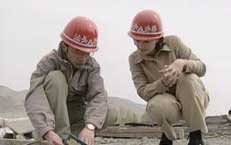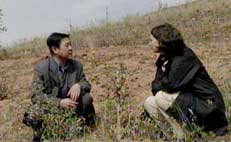 In the first year of the development of the west, Qinghai province conducted a series of ecological projects such as making fields into forests and grassland in line with the central government's demand to improve the local environment. With the support of the central government, Qinghai has begun the project of transferring natural gas eastwards, building expressways, producing potassium fertilizer, and focusing on ecological reconstruction and economic development at the same time. In the first year of the development of the west, Qinghai province conducted a series of ecological projects such as making fields into forests and grassland in line with the central government's demand to improve the local environment. With the support of the central government, Qinghai has begun the project of transferring natural gas eastwards, building expressways, producing potassium fertilizer, and focusing on ecological reconstruction and economic development at the same time.
The haidong region is one of the largest agricultural areas near the origin of the Yellow River. In the past, the local people cleared the natural forest to grow their crops, which had a disastrous effect on the environment. These days, however, in Haidong, they are returning their grainplots to forest and grasslands. This year for example, has seen almost 11,000 hectares change into forest and grasslands.
 Now let's go to Pingan County and Hualong County in Haidong to see how they have returned their grain fields to forests. With us are the people in charge of this project from the Forestry Bureau of Qinghai. Four out of six counties in Haidong have been labeled as economically poor by the central government. With a limited variety of crops and a low level of cultivation, the farmers are working on vast fields but reap very little. The harvest largely relies on climate and rainfall, so a farmer's annual income stands at about only US$100. This year, the government decided to give farmers grain and cash subsidies in accordance with the amount of fields that they have returned to forests and grassland. What then has been the effect? Now let's go to Pingan County and Hualong County in Haidong to see how they have returned their grain fields to forests. With us are the people in charge of this project from the Forestry Bureau of Qinghai. Four out of six counties in Haidong have been labeled as economically poor by the central government. With a limited variety of crops and a low level of cultivation, the farmers are working on vast fields but reap very little. The harvest largely relies on climate and rainfall, so a farmer's annual income stands at about only US$100. This year, the government decided to give farmers grain and cash subsidies in accordance with the amount of fields that they have returned to forests and grassland. What then has been the effect?
Interview: Township Cadre
This is field that has been returned to forests. We mainly plant poplar and sallow thorn here. We plant seedlings to suit the dry climate here. By first soaking the saplings in water for a while and then planting them on the mountain, we can assure the survival rate of the trees. Poplars and sallow thorn are mixed together to accelerate growth and to improve soil fertility.
Interview: Rural household
CH: Hello!
Farmer: Hello!
CH: Is this your house?
Farmer: Yes.
CH: How many people are there in your family?
Farmer: Six.
CH: What's your name?
Girl: My name is Dai Yuxiu.
CH: Do you like going to school?
Girl: Yes, I do.
CH: May I come in?
Farmer: Yes, please.
Farmer: We used to have about one hectare to grow grain, but now 0.8 of the hectare has been returned to forest area. We were granted a subsidy from the government of 1,200 kg of grain and US$30 grass seeds and saplings. We live pretty well now.
 Haidong plans to reforest 340,000 hectares of former grain fields and barren hills in 6 years, which will take up 57.5% of Qinghai's total area. Haidong plans to reforest 340,000 hectares of former grain fields and barren hills in 6 years, which will take up 57.5% of Qinghai's total area.
The Seninglan gas pipeline project is a key enterprise in the construction of a developed western region. Once complete, this gaspipe will distribute natural gas to more than 4 million people living along the pipeline's area. This better quality fuel will not only improve production levels in Qinghai and Gansu, but it will also, more importantly, reduce pollution levels and create a better environment.
Covering a length of 935 km, the Seninglan Pipeline traverses through 17 cities, towns and counties in Qinghai and Gansu. It starts from the Sebei natural gas field near the Chalhan salt lake in the Qaidam Basin in the west, and ends in Lanzhou city, the capital of Gansu in the east. Now the project has consumed a total investment of over US$300 million and more than 800 km of pipeline has been completed. This indicates 93% of the whole project is now complete. The construction department is stepping up their work to finish the project 5 months earlier than planned. He Xiaohong, who is in charge of construction, told us that the Seninglan gas pipeline, which cuts through the Gobi Desert, grasslands and cities, has benefited urban, rural and pastoral residents. By replacing roots and stems with gas fuel, the pipeline has played a positive part in the refinement of fuel structure and the protection of plants. Moreover, the pipeline will transport abundant raw materials for the development of the petrochemical industry in the west.
Here we are at the building site of the first expressway on the Qingzang Plateau. When complete the expressway will further boost economic development. It will link Xining with Lanzhou. In this year alone, over 2 billion yuan will be spent on road construction, which is equal to the total investment in this region during the past 40 years.
Running a length of 34.78km, the first part of the Xining-Lanzhou Expressway was built in February of this year with a total investment of US$140 million. As an express passage linking Xining and Lanzhou, it will change the low standard and low speed roads in Qinghai, and upgrade road transport facilities within the province. Qinghai has invested more than US$60,000 into the reconstruction of 5 tourist routes, facilitating the transportation of both tourists and investors.
Interview: Official Bureau of Expressway Management
This is the first expressway built in Qinghai, and it is also the highest expressway above sea level in China. The express passage connects the two capital cities, Xining and Lanzhou, spurring the economic growth of Qinghai.
Qinghai's Potassium Fertilizer Project is one of the 10 major projects launched by the Chinese government in the drive to develop the west. With an investment of over US$800 million, the project will produce one million tons of muriate. The Chalhan salt lake has the largest deposit of soluble potassium and magnesium in inland China, among which magnesium chloride and muriate cover 97% of China's total reserve. Meanwhile, Chalhan also boasts many rare elements, such as boron, lithium, bromine, iodine, and rubidium. Chalhan salt lake will serve as a production base for the salt chemical industry.
At present, some institutes and volunteers from abroad are actively joining in to assist education and other causes in Qinghai. As volunteers, chief representative Bruce Mcdowall and medical representative Dr. Steven Wang are offering their help to Zeku County to improve primary education and health care.
The development of Qinghai is still at an early stage. To direct the development of resources and enterprises toward improved high-tech and high added value, the support and cooperation from the east and international communities in technology, capital, and management are indispensable. Qinghai has joined the world through these common opportunities and challenges.
Perhaps in five or ten years, people will see a brand new western region through the spectacular achievements of the west's development. A brand new century brings a brand new image of western China. Here people in Qinghai are trying their best, so let's wait and see how things turn out. Thanks for watching. I'm Cecilia Homerlein.
|









